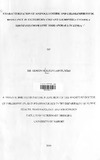| dc.description.abstract | The emergence of antimicrobial resistance among pathogenic and commensal bacteria
has become a serious problem worldwide and an understanding of the molecular mechanisms
by which it emerges and spreads is crucial in designing intervention strategies to reduce its
progression. In this study, the prevalence and antimicrobial susceptibility of Escherichia coli
and Salmonella isolates from food animals were determined. Thirty E. coli and three
Salmonella enterica isolates were characterized for the molecular basis of amino glycoside and
chloramphenicol resistance. A total of 235 (82.5%) and 16 (5.6%) of 285 samples were
positive for E. coli and Salmonella isolates, respectively. The isolation rate for E. coli was
72.7%, 84.7% and 90.5% in samples from cattle, chickens and pigs, respectively and ranged
from 0.0% in cattle and chickens to 13.8% in pigs for Salmonella. Three Salmonella serotypes
were identified, with Salmonella enterica subsp. enterica serotype Saintpaul (S. Saintpaul)
being the predominant serotype (64.3%) followed by S. Heidelberg and S. Braenderup.
Among the E. coli isolates, resistance was found in 65.5% and multidrug-resistance
(resistance to 2: 2 antimicrobials) in 37.9% of the isolates. Resistance was more frequently
observed in chicken isolates. The most common resistances were to ampicillin, streptomycin,
tetracycline, sulphamethoxazole/trimethoprim or kanamycin (42.5-1l.9%). Resistances to
kanamycin, sulphamethoxazole/trimethoprim, and tetracycline were significantly lower III
isolates from cattle (2.5-7.5%) than from the other species (12.0-40.0%) (p < 0.01).
Resistance to streptomycin was significantly higher in cattle and chicken than in pigs while
resistance to ampicillin was higher in pigs (p = 0.001). Chloramphenicol resistance varied
from 2.0% in chickens to 9.5% in pigs. Similar antimicrobial resistance rates were observed
among the faecal (29.9%) and carcass swab (33.1 %) E. coli isolates from both cattle and pigs.
Forty resistance patterns were recorded. For Salmonella, resistance to at least ampicillin,
chloramphenicol, streptomycin or tetracycline was observed in 37.5% and multidrug
resistance in 12.5% of the Salmonella isolates belonging to serotypes Saintpaul and
Braenderup. Twenty three (76.7%) of 30 E. coli isolates characterized for the molecular basis
of aminoglycoside and chloramphenicol resistance harboured plasmids ranging in size from 2
to 106 kb while all three Salmonella isolates were plasmid-free. Twenty eight (96.6%) of the
29 E. coli and two of the Salmonella isolates resistant to streptomycin contained at least one
of the two streptomycin resistance genes tested. All Salmonella isolates were positive for strA
gene only. Among the E. coli isolates, 21 (72.4%) were positive for strA and aadAl while the
• remaining seven isolates (24.1 %) were positive for strA gene only. The catAl gene was
detected in all the chloramphenicol-resistant E. coli and Salmonella isolates. All the
kanamycin- and/or gentamicin-resistant E. coli isolates were negative for the two genes
analysed.
Sequence analysis of an unusual large strA amplicon of -1.2 kb from E. coli isolates
revealed disruption of the strA gene by the insertion of a functionally active trimethoprim
resistance gene cassette dfrA14. Such amplicons were observed in 10 isolates, all of which
harboured also the aadAl gene. Two small plasmids of 6 and 8 kb mediating resistance to
streptomycin and sulphonamides, and to streptomycin, sulphonamides and tetracycline,
respectively, were identified. The strA gene was physically linked to the sulphonamide
resistance gene sul2 in both plasmids. The strA and catAl genes were conjugally cotransferred
with resistances to ampicillin, tetracycline and sulphamethoxazole/trimethoprim.
The aadAl gene was found as cassette-borne gene within class 1 integrons and was linked to
trimethoprim resistance gene cassette dfrAI.
This study shows that multidrug resistant (MDR) E. coli isolates are prevalent in cattle,
pigs and chickens and on fresh cattle and pig carcasses in Kenya. Secondly, Salmonella is
present in pigs at slaughter and on pork carcasses, and pigs are a potential source of single and
multiple antimicrobial-resistant non-typhoidal Salmonella enterica subsp. enterica serotypes
that could pose a public health hazard in human infections. To my knowledge this is the first
report of S. Heidelberg among food animals in Kenya. The most prevalent resistance patterns
observed in this study were towards antimicrobial agents commonly used in food animals.
The data suggest that selection pressure imposed by the use of tetracycline derivatives,
aminoglycosides, sulphonamides and penicillins in food animals is a key driving force in the
selection of antimicrobial resistance in E. coli and non-typhoidal Salmonella enterica subsp.
enterica serotypes. This study further revealed that E. coli and Salmonella serotypes
Braenderup and Saintpaul from food animals in Kenya may represent a reservoir of
streptomycin and chloramphenicol resistance genes which may be transferable to other
bacteria. The physical linkage of streptomycin resistance gene strA to sulphonamide
resistance gene sul2 offers the possibility of co-selection of either of these genes when there is
selective pressure imposed by the use anyone of the antimicrobials. The location of strA and
catAl genes on conjugative plasmids and the aadAl gene within class 1 integrons constitute
an effective way to spread streptomycin and chloramphenicol resistances among bacteria from
different ecosystems.
It is recommended that prudent use of antimicrobials in food animals should be
encouraged, slaughter hygiene improved and adequate heat processing of foods of animal
origin in order to minimize the risk of transfer of antimicrobial resistant bacteria to humans. A
national antimicrobial resistance surveillance program in food animals and detailed
epidemiological and molecular studies on acquisition of resistance genes and distribution of
antimicrobial-resistant E. coli and Salmonella isolates among food animals, food products and
humans in Kenya are necessary. | en |

